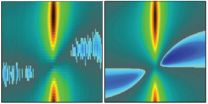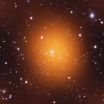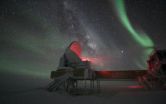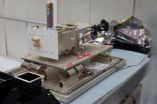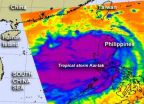Immediate recommended actions include completion of projects in the current program of NASA and the National Science Foundation, creation of a new "mid-scale" line of projects at NSF, augmentation of NASA and NSF "enabling" programs, and acceleration and expansion of NASA's Heliophysics Explorer Program. The report also recommends beginning later in the decade new moderate-size NASA missions to address high-priority science targets, as well as a multiagency initiative to address pressing needs for improved forecasts of space weather and predictions of its impacts on society.
"The significant achievements of the past decade set the stage for transformative advances in solar and space physics," said Daniel Baker, director of the Laboratory for Atmospheric and Space Physics at the University of Colorado, Boulder, and chair of the committee that wrote the report. "In turn, these advances will support critical national needs for information that can be used to anticipate, recognize, and mitigate space weather effects that are adverse to human life and the technological systems society depends upon," he said.
"The proposed strategy directed at NSF, NASA, and also NOAA is one that recognizes the increased societal importance of solar and space physics, and how important it is to tackle these new opportunities with a diverse set of tools -- from miniature satellites like cubesats to moderate and large missions," said Thomas Zurbuchen, a professor and associate dean for entrepreneurship at the University of Michigan's College of Engineering and vice chair of the study committee.
Four scientific goals should drive solar and space physics in the next 10 years, the report says. These are to establish the origins of the sun's activity and predict variations in the space environment; determine the dynamics and coupling of Earth's magnetosphere, ionosphere, and atmosphere and their response to solar and terrestrial inputs; understand the interaction of the sun with the solar system and the interstellar medium; and discover and characterize fundamental processes that occur both within the heliosphere and throughout the universe.
Taking into account cost, schedule, and complexity, the decadal survey provides a number of research recommendations to reach these goals. It also considers challenges that could impede achievement of the recommended program, including budget issues, the necessity to coordinate activities across multiple agencies, and the limited availability of appropriately sized and affordable space launch vehicles.
The report says that support should continue in the near term for the key existing program elements that comprise the Heliophysics Systems Observatory -- the entire fleet of heliospheric, geospace, and planetary spacecraft -- and for successful implementation of programs in advanced stages of development.
Additional recommendations include establishing a new, integrated multiagency initiative -- DRIVE -- that will more effectively exploit NASA and NSF scientific assets. Five directives make up the DRIVE initiative: Diversify observing platforms with microsatellites and mid-scale ground-based assets; Realize scientific potential by sufficiently funding operations and data analysis; Integrate observing platforms and strengthen ties between agency disciplines; Venture forward with science centers and instrument and technology development; and Educate, empower, and inspire the next generation of space researchers.
NASA should also accelerate and expand the Heliophysics Explorer program, which provides frequent flight opportunities to enable the definition, development, and implementation of mission concepts. Augmenting the current program by $70 million per year, in fiscal year 2012 dollars, will restore the option of mid-size Explorers, allowing them to alternate with small Explorers every 2 to 3 years. As part of the augmented Explorer program, NASA should support regular selections of "Missions of Opportunity," which allow the research community to respond quickly and to leverage limited resources with interagency, international, and commercial flight partnerships. For relatively modest investments, such opportunities can potentially address high-priority science aims identified in this survey.
New moderate- and large-class missions later in the decade would investigate space physics at the edge of the heliosphere where the sun's influence wanes, the effects of processes in Earth's lower atmosphere on conditions in space, fundamental questions related to the creation and transport of plasma in Earth's ionosphere and magnetosphere, and how the Earth responds globally to magnetic storms from the sun.
###
The study was sponsored by NASA and the National Science Foundation. The National Academy of Sciences, National Academy of Engineering, Institute of Medicine, and National Research Council make up the National Academies. They are private, nonprofit institutions that provide science, technology, and health policy advice under a congressional charter. The Research Council is the principal operating agency of the National Academy of Sciences and the National Academy of Engineering. For more information, visit http://national-academies.org. A committee roster follows.
Contacts:
Lorin Hancock, Media Relations Officer
Shaquanna Shields, Media Relations Assistant
Office of News and Public Information
202-334-2138; e-mail news@nas.edu
Pre-publication copies of Solar and Space Physics: A Science for a Technological Society are available from the National Academies Press; tel. 202-334-3313 or 1-800-624-6242 or on the Internet at http://www.nap.edu. Reporters may obtain a copy from the Office of News and Public Information (contacts listed above).
NATIONAL RESEARCH COUNCIL
Division on Engineering and Physical Sciences
Aeronautics and Space Engineering Board
Space Studies Board
Committee on a Decadal Strategy for Solar and Space Physics (Heliophysics)
Daniel N. Baker1¬¬¬ (chair)
Director
Laboratory for Atmospheric and
Space Physics
University of Colorado
Boulder
Thomas H. Zurbuchen (vice chair)
Professor of Space Science and Engineering
Department of Atmospheric, Oceanic, and Space Sciences
University of Michigan
Ann Arbor
Brian J. Anderson
Physicist
Applied Physics Laboratory
Johns Hopkins University
Laurel, Md.
Steven J. Battel
President
Battel Engineering
Scottsdale, Ariz.
James F. Drake Jr.
Professor
Department of Physics and Institute
for Physical Science and Technology
University of Maryland
College Park
Lennard A. Fisk2
Thomas M. Donahue Distinguished
University Professor of Space Science
Department of Atmospheric, Oceanic, and Space Sciences
University of Michigan
Ann Arbor
Marvin A. Geller
Professor of Atmospheric Sciences
School of Marine and Atmospheric Sciences
Stony Brook University
Stony Brook, N.Y.
Sarah Gibson
Scientist III
High Altitude Observatory
National Center for Atmospheric Research
Boulder, Colo.
Michael A. Hesse
Director
Heliophysics Science Division
NASA Goddard Space Flight Center
Greenbelt, Md.
J. Todd Hoeksema
Senior Research Scientist
W.W. Hansen Experimental Physics
Laboratory
Stanford University
Stanford, Calif.
Mary K. Hudson
Eleanor and A. Kelvin Smith Distinguished Professor of Physics
Department of Physics and Astronomy
Dartmouth College
Hanover, N.H.
David L. Hysell
Professor
Department of Earth and Atmospheric Sciences
Cornell University
Ithaca, N.Y.
Thomas J. Immel
Associate Research Physicist
Space Sciences Laboratory
University of California
Berkeley
Justin Kasper
Astrophysicist
High Energy Astrophysics Division
Harvard-Smithsonian Center for Astrophysics
Cambridge, Mass.
Judith L. Lean2
Senior Scientist for Sun-Earth System Research
Space Science Division
Naval Research Laboratory
Washington, D.C.
Ramon E. Lopez
Professor of Physics
University of Texas
Arlington
Howard J. Singer
Chief Scientist
Space Weather Prediction Center
National Oceanic and Atmospheric Administration
Boulder, Colo.
Harlan E. Spence
Professor of Physics
Director
Institute for the Study of Earth,
Oceans, and Space
University of New Hampshire
Durham
Edward C. Stone2
David Morrisroe Professor of Physics, and
Director
Space Radiation Laboratory
California Institute of Technology
Pasadena, Calif.
STAFF
Arthur Charo
Study Director
1 Member, National Academy of Engineering
2 Member, National Academy of Sciences
END

